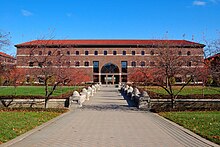Purdue University School of Electrical and Computer Engineering
40°25.86′N 86°54.87′W / 40.43100°N 86.91450°W
 MSEE Building | |
| Type | Public |
|---|---|
| Established | 1888 |
| Head | Professor Ragu Balakrishnan |
| Address | 465 Northwestern Ave. , , , West Lafayette, IN 47907-2035 |
| Affiliations | Purdue University |
| Website | https://engineering.purdue.edu/ECE |
The School of Electrical and Computer Engineering (ECE) at Purdue University offers both undergraduate B.S. degree as well as M.S. and Ph.D. graduate degrees in Electrical Engineering and Computer Engineering. The school of ECE enrolls approximately one thousand undergraduates (sophomores through seniors) and five hundred graduate students as full-time students. U.S. News & World Report ranks Purdue's Electrical/Electronic Engineering and Computer Engineering 9th and 11th respectively at the Undergraduate level [America's Best Colleges 2011]. The Graduate programs in both Computer Engineering and Electrical Engineering are ranked 10th in the nation [America's Best Graduate Schools 2009][1]
History
The School of Electrical and Computer Engineering (ECE) has a history of research and education that dates back to 1888. Many landmark innovations in radiotelephony, television, and electric power were developed by Purdue faculty[citation needed]
Mission statement
"The Purdue School of Electrical and Computer Engineering enriches society and advances engineering in three crucial ways: by educating electrical and computer engineering students from Indiana, the country, and the world so that they have the knowledge, ability, and skills to innovate, excel and lead in their professions; by contributing to the benefit of humanity through the discovery of fundamental knowledge, the solution of current technological problems, and the development of new applications; and finally, by sharing knowledge and expertise through meaningful engagement within and outside the Purdue community."
Facts and figures
- Largest department/school at Purdue University and one of the largest in the nation.
- Highest volume of research among all schools and departments at Purdue.
- Birthplace of the Engineering Projects In Community Service (EPICS) program, the Birck Nanotechnology Center, and the Engineering Computer Network.
- Faculty include 23 IEEE Fellows, four members of the National Academy of Engineering (NAE), two NAE Gordon Prize winners, one National Medal of Technology Lauriat, and the President of the IEEE
- The school attracts more than 1,500 applicants to its graduate program annually.
- The first electronic television was made in ECE.
- Former Head of ECE, Reginald Fessenden, invented radio telephony.
Areas of interest
The School of Electrical and Computer Engineering currently offers electives in the following areas of interest:
- Automatic Control
- Biomedical Imaging and Sensing
- Communications, Networking, Signal & Image Processing
- Computer Engineering
- Power and Energy Devices and Systems
- Fields and Optics
- Microelectronics and Nanotechnology
- VLSI and Circuit Design
- Education
Birck Nanotechnology Center (BNC)
The Birck Nanotechnology Center has its birthplace in the School of Electrical and Computer Engineering at Purdue University. It is dedicated to nanoscale science and engineering, particularly nanotechnologies addressing societal challenges and opportunities in computing, communications, the environment, security, energy independence, and health.
The BNC opened in July 2005. This $58 million facility comprises 187,000 square feet (17,400 m2), providing office space for 45 faculty, 21 clerical and technical staff, and up to 180 graduate students. The heart of the building is a 25,000 sq ft (2,300 m2). Class 1-10-100 (ISO class 3-4-5) nanofabrication cleanroom, part of which is configured as a biomolecular cleanroom with separate entry and gowning areas and isolated air flow. The building also includes over 22,000 sq ft (2,000 m2). of laboratory space external to the cleanroom, including special low vibration rooms for nanostructures research, with temperature control to less than 0.1 °C. Other laboratories are specialized for nanophotonics, crystal growth, bio-nanotechnology, molecular electronics, MEMS and NEMS, surface analysis, SEM/TEM, electrical characterization, RF systems, instruction and training, and precision micro-machining. In addition, a nanotechnology incubator facility is provided for interaction with industry.
Labs and facilities

- Communication Research Laboratory (CRLAB)
- Coherent and Quantum Optics Laboratory
- Embedded Systems Laboratory (ESL)
- Energy Conversion Research Laboratory (ECRL)
- Energy Systems Analysis Consortium (ESAC)
- Genetic Optimization Processing Array (GOPA)
- Haptic Interface Research Laboratory (HIRL)
- High-Efficiency, Low-Power Systems (HELPS)
- High-Performance Computing Laboratory (HPCLab)
- Integrated Designs of Electromagnetically Applied Systems (IDEAS) Laboratory
- Integrated Systems Laboratory (ISL)
- Laboratory for Active Sensing Systems (LASS)
- Laboratory for Integrated BioMedical Micro/Nanotechnology and Applications (LIBNA)
- Nanomaterials Integration and Assembly Laboratory (NIAL)
- Nanoelectronics Research Laboratory (NRL)
- NASA Institute for Nanoelectronics and Computing (INAC)
- Naval Combat Survivability Testbed (NCST)
- Network for Computational Nanotechnology (NCN)
- Photonics and Spectroscopy Laboratory (PSL) Facilities
- Purdue Robot Vision Laboratory (RVL)
- Purdue University Rendering and Perceptualization Laboratory (PURPL)
- Spread Spectrum and Satellite Communications Research Laboratory (S3CRL)
- Ultrafast Optics and Optical Fiber Communications Laboratory
- Video and Image Processing Laboratory (VIPER)
Complete list of Research Groups, Laboratories and Centers.[4]
Student organizations
- Engineers for a Sustainable World (ESW)
- Eta Kappa Nu, Beta Chapter (HKN) - International Honor Society for Electrical Engineers
- IEEE - Student Chapter
- IEEE Computer Society - Student Chapter
- Purdue Student Engineering Foundation (PSEF)
- EPICS - Engineering Projects in Community Service
- National Society of Black Engineers (NSBE)
- Society of Mexican American Engineers and Scientists (MAES)
- Society of Hispanic Professional Engineers (SHPE)
- Society of Women Engineers (SWE)
- Tau Beta Pi - National Engineering Honor Society
- PEM - Purdue Engineering Magazine
- Purdue Engineering Student Council (PESC)
References
- ^ "U.S. News & World Report Rankings". Purdue University.
- ^ "Mission Statement". Purdue University.
- ^ "Facts and Figures". Purdue University.
- ^ "Research Groups, Laboratories and Centers". Purdue University.

